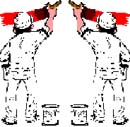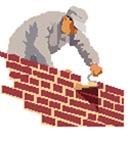Definitions in energy metabolism
On this page:
Units of energy
The SI unit of energy is the Joule. 1 Joule is a small amount
of energy, and in nutrition and physiology it is usual to work in kJ (1,000
Joules) or MJ (1,000,000 Joules)
Many people prefer to use the calorie. 1 calorie is the amount
of heat required to raise the temperature of 1 g of water through 1 degree C,
from 14.5C to 15.5C. Again in nutrition and physiology it is usual to work in
kcal (1,000 cal); this is sometimes shown as Cal with a capital C, to differentiate
it from a single calorie with a lower case c.
Basal metabolic rate (BMR)
The basal metabolic rate is the energy cost of maintaining metabolic homeostasis,
nerve and muscle tone and circulation and breathing.
It is the energy expenditure measured when completely at rest, but awake, at
a comfortable temperature (i.e. under conditions of thermal neutrality, so that
the subject is not expending energy to keep warm or cool down), and several
hours after the last meal, so that the subject is not expending energy on processing
the products of digestion to synthesise body reserves of fat and glycogen.
The importance of being awake is that some people show an increase in metabolic
activity when they are asleep, as a result of partial uncoupling of electron
transport from ATP synthesis - this is a mechanism for regulating body weight
as food intake varies. Other people show a fall in metabolic activity when they
are asleep; such people are metabolically efficient, but are more likely to
gain weight as a result of increased food intake.
 Basal
metabolic rate depends on metabolically active lean body tissue; mainly muscle,
but all tissues make a contribution - although it is largely inert reserves
of triacylglycerol, adipose tissue also makes a contribution to metabolic rate.
Body weight is therefore an important factor in determining BMR, but gender
and age are also important.
Basal
metabolic rate depends on metabolically active lean body tissue; mainly muscle,
but all tissues make a contribution - although it is largely inert reserves
of triacylglycerol, adipose tissue also makes a contribution to metabolic rate.
Body weight is therefore an important factor in determining BMR, but gender
and age are also important.
Women have a higher proportion of body weight as fat than do men. This means
that a woman has a lower BMR than a man of the same body weight.
With increasing age, even if body weight does not change, lean muscle tissue
is gradually replaced by fat, so that the proportion of fat in the body increases
with age. This means that an older person has a lower BMR than a younger person
of the same age.
Resting metabolic rate (RMR)
It is not always possible to determine BMR under strictly controlled conditions.
When the conditions are not completely controlled, the resultant measurement
of energy expenditure is called the resting metabolic rate; for practical purposes,
resting metabolic rate can be considered to be approximately equivalent to basal
metabolic rate.
Physical activity ratio (PAR)
PAR is the energy cost of an activity, expressed as a multiple of BMR. Values
range from only just > 1.0 for very gentle activities up to 8 x BMR or even
higher for very intense activity.
 PAR
1.0 – 1.4
PAR
1.0 – 1.4
lying, standing or sitting at rest, e.g. watching TV, reading, writing, eating,
playing cards
 PAR
1.5 – 1.8
PAR
1.5 – 1.8
sitting: sewing, knitting, playing piano, driving, standing: preparing vegetables,
washing dishes, ironing, office and lab work
 PAR
1.9 – 2.4
PAR
1.9 – 2.4
standing: mixed household chores, cooking, playing snooker or bowls
 PAR
2.5 – 3.3
PAR
2.5 – 3.3
standing: dressing, undressing, showering, vacuum cleaning, walking: 4 –
6 km /h, playing cricket,
occupational: tailoring, shoemaking, electrical and machine tool, industry,
painting and decorating
 PAR
3.4 – 4.4
PAR
3.4 – 4.4
standing: mopping floors, gardening, cleaning windows, walking: 4 – 6
km /h, playing golf,
occupational: motor vehicle repairs, carpentry and joinery,
chemical industry, bricklaying
 PAR
4.5 – 5.9
PAR
4.5 – 5.9
standing: polishing furniture, chopping wood, heavy gardening, walking: 6 -
7 km /h,
exercise: dancing, moderate swimming, gentle cycling
occupational: labouring, hoeing, road construction, digging
and shovelling, felling trees
 PAR
6.0 – 7.9
PAR
6.0 – 7.9
walking: uphill with load or cross-country, climbing stairs,
exercise: jogging, cycling, skiing, tennis, football
Physical activity level (PAL)
Some-one's overall physical activity level is calculated by summing the various
activities during the day, multiplied by the time spent in each activity as
a proportion of the day. Again it is expressed as a multiple of BMR. The UK
Department of Health classification of occupational work during the typical
8 hours working day (excluding leisure activities) are as follows:
 Light
work: PAR = 1.7
Light
work: PAR = 1.7
professional, clerical and technical workers, administrative and managerial
staff, sales representatives, housewives
 Moderate
work: PAR = 2.2 (women) – 2.7 (men)
Moderate
work: PAR = 2.2 (women) – 2.7 (men)
sales staff, domestic service, students, transport workers, joiners, roofing
workers
 Moderately
heavy work – PAR 2.3 (women) – 3.0 (men)
Moderately
heavy work – PAR 2.3 (women) – 3.0 (men)
machine operators, labourers, agricultural workers, bricklaying, masonry
 Heavy
work: PAR = 2.8 (women) – 3.8 (men)
Heavy
work: PAR = 2.8 (women) – 3.8 (men)
labourers, agricultural workers, bricklaying, masonry, where there is little
or no mechanisation
These figures exclude leisure activities; a desirable physical activity level
for cardiovascular and general health is 1.7 x BMR, a figure that is achieved
in UK by only some 22% of men and 13% of women. The average PAL in UK is 1.4
x BMR.
In the simulation program you will complete an activity diary for your subject,
which will permit you to determine PAL and total energy requirement.
Diet-induced thermogenesis (DIT)
The increase in metabolic activity after a meal, as a result of the energy
cost of digestion and absorption, and, more importantly, the energy cost of
synthesising reserves of glycogen, triacylglycerol and protein. It may be as
much as 10 - 15% of the energy yield of the meal.
Total energy expenditure (TEE)
The total expenditure of energy (and hence the total energy requirement to
maintain body weight) in kJ or kcal, calculated from BMR x PAL + an estimate
of DIT.
 Basal
metabolic rate depends on metabolically active lean body tissue; mainly muscle,
but all tissues make a contribution - although it is largely inert reserves
of triacylglycerol, adipose tissue also makes a contribution to metabolic rate.
Body weight is therefore an important factor in determining BMR, but gender
and age are also important.
Basal
metabolic rate depends on metabolically active lean body tissue; mainly muscle,
but all tissues make a contribution - although it is largely inert reserves
of triacylglycerol, adipose tissue also makes a contribution to metabolic rate.
Body weight is therefore an important factor in determining BMR, but gender
and age are also important. PAR
1.0 – 1.4
PAR
1.0 – 1.4 PAR
1.5 – 1.8
PAR
1.5 – 1.8 PAR
1.9 – 2.4
PAR
1.9 – 2.4 PAR
2.5 – 3.3
PAR
2.5 – 3.3 PAR
3.4 – 4.4
PAR
3.4 – 4.4 PAR
4.5 – 5.9
PAR
4.5 – 5.9 PAR
6.0 – 7.9
PAR
6.0 – 7.9 Light
work: PAR = 1.7
Light
work: PAR = 1.7 Moderate
work: PAR = 2.2 (women) – 2.7 (men)
Moderate
work: PAR = 2.2 (women) – 2.7 (men) Moderately
heavy work – PAR 2.3 (women) – 3.0 (men)
Moderately
heavy work – PAR 2.3 (women) – 3.0 (men) Heavy
work: PAR = 2.8 (women) – 3.8 (men)
Heavy
work: PAR = 2.8 (women) – 3.8 (men)